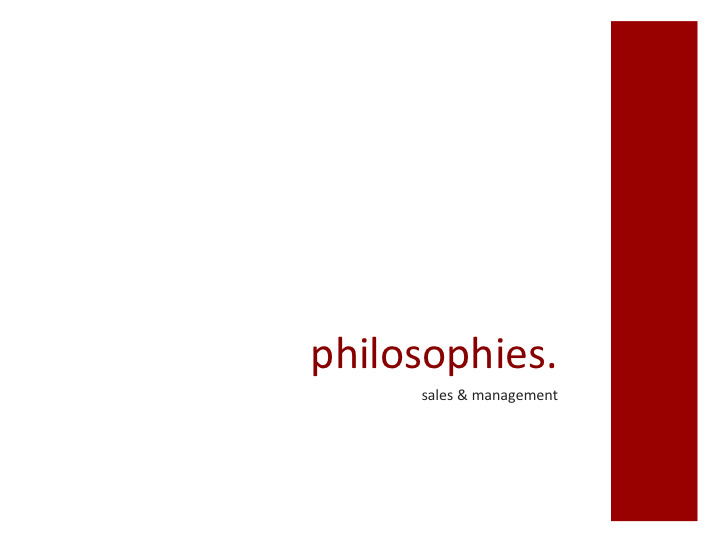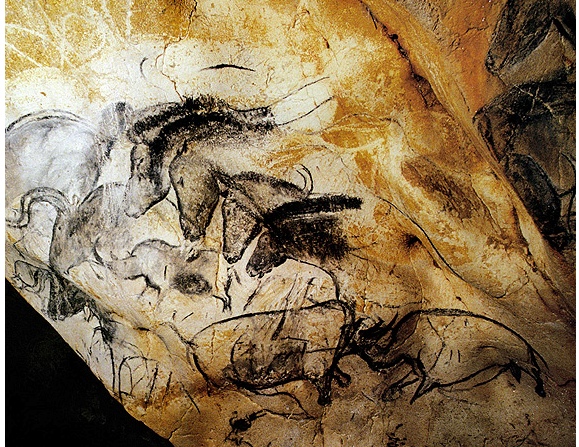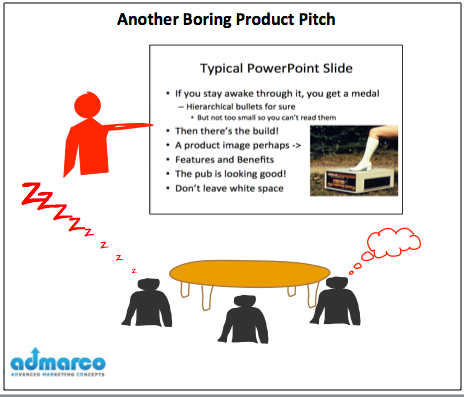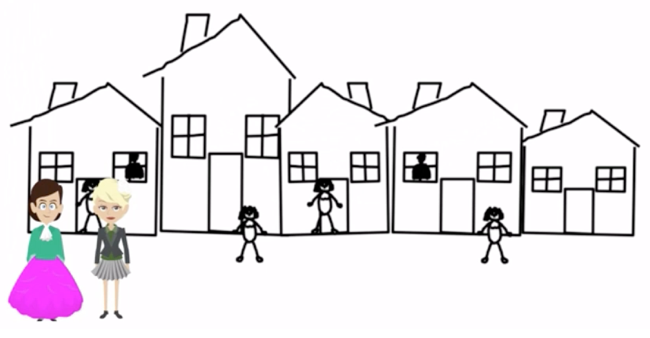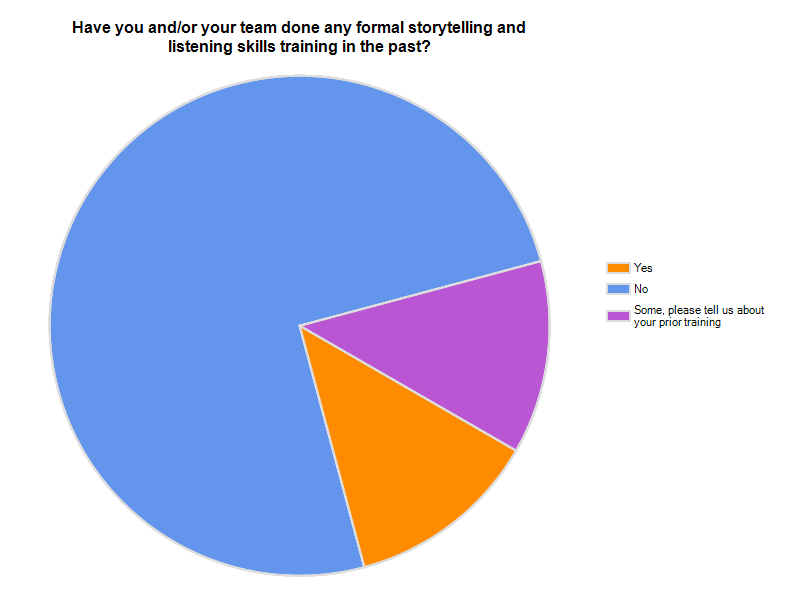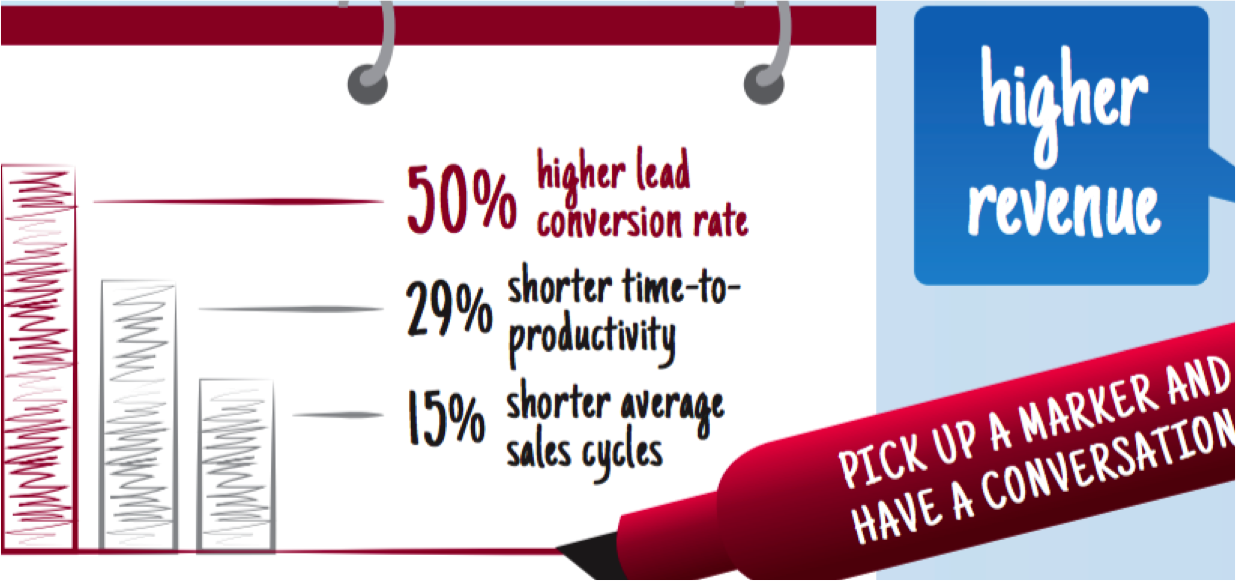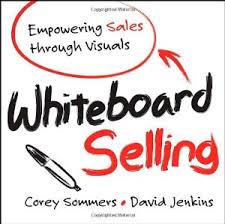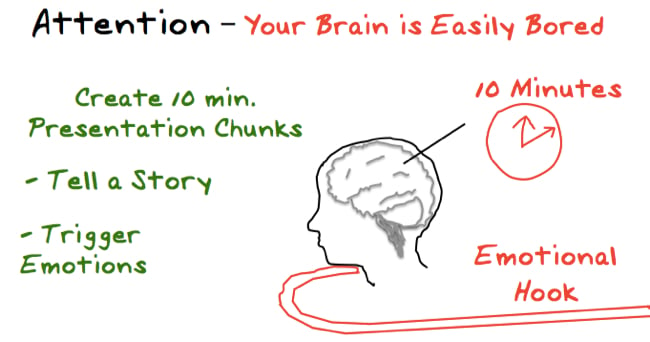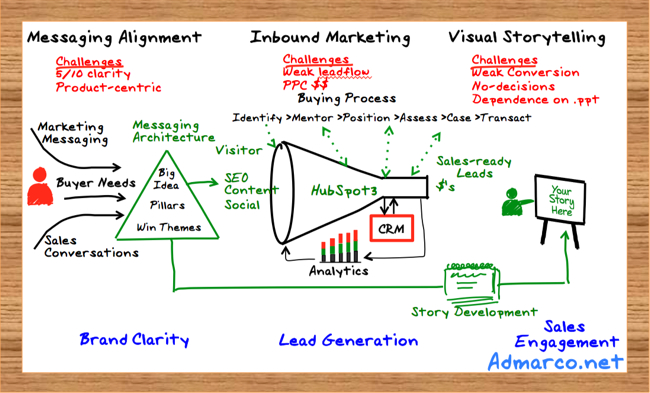I had dinner with a Sales VP of an early stage technology company this week and discussed her business and her experience in building the startup revenue stream. We got down to talking about "the how" of building the sales team, recruiting the channel and generating revenue.
They now have 6 people in sales globally and their resellers are starting to sell their product, although she mentions it was a painful process in getting there.
3 min read
Start-up Sales VP Regrets - I wish I had done this 2 years ago
By Mark Gibson on Oct 27, 2021 11:23:06 AM
Topics: inbound marketing visual storytelling lean startups steve blank
3 min read
Using Visual Storytelling to Get Your Next Job - Case Study
By Mark Gibson on Oct 27, 2021 11:23:06 AM
"I'm sorry to tell you that we are restructuring the company and we have to let you and twelve others go."
Ever been laid off? I have - and chances are that at some time in your life it could happen to you. Layoff's happen, it's a fact of life in our time and it's no big deal. Companies re-organize, merge, get acquired, have a bad quarter and suddenly, headcount becomes a problem.
After 9-11, there were hundreds of thousands of sales and marketing professionals in the Bay Area suddenly unemployed. Long gone is the era of my parents (grand-parents for many readers), when you joined a company and expected to work a lifetime and retire on a pension at 65.
What happens when you do get laid off? How do you get back into the workforce and perhaps more importantly, how do you win the job you really want, when there are potentially dozens or even hundreds of others applying for the same job? Hint - be different!
Wil Loesel (www.linkedin.com/in/wloesel) worked for Time Warner Cable as a sales manager and was recently laid off due to a restructuring. Wil visited my Website earlier this month and viewed our "Your PowerPoint Presentations Suck Webinar" and decided to apply some of the ideas he learned in the Webinar to differentiate himself in his job search.
Wil's Story
"I had an interview for a B2C Manager position on May 5th. I had prepared a presentation a week earlier for another company I was interviewing at and was working on tailoring it for my interview the next day. I watched your webinar the evening prior to my interview and decided I wanted to change my entire presentation.
I stayed up all night (until 8am) revising the presentation. I then slept for 2 hours, woke up and kept working, all the way until my interview. I wrote and memorized talking points and stories for each slide (keeping the slides visual, using only a word or two and a picture) and let my voice present the story."
Wil's Before Slides
There is nothing wrong with Wil's before slides, it's just that they are typical, the same meaningless graphics, too much information and have a memory retention lifecycle for the viewer of one mouse-click.
This is one of the worst slides in Wil's old deck, but it's so familiar. I've seen something like this many times and when I see it my eyes glaze over it and move on.
The slide below is popular at the moment. I have seen a derivative of this several times at industry conferences and Webinars already this year. It is unreadable and has too much information to be presented effectively.
Wil's After Slides
I have reduced the size of Wil's "after" slides to cover the points in his management philosophy section, because I can... you will still be able to get the key idea from each slide that Wil wanted to discuss, when the slides are shrunk. The images are clean, one main idea per slide, are easily understood and the images create meaning to support his point. It's Wil that is talking, the slides are doing their job as visual aids.
Topics: sales powerpoint visual storytelling
3 min read
Cave-Man, Selling and the Art of Visual Storytelling
By Mark Gibson on Oct 27, 2021 11:23:06 AM
Are you familiar with the Paleolithic cave paintings of Lascaux or Chauvet Caves in France? If you are not, please click on this link to the Chauvet Cave Paintings.
Topics: visual storytelling whiteboarding visual perception cave-art
1 min read
Your PowerPoint Presentations Suck Pt. 1 Visual Perception -Video
By Mark Gibson on Sep 10, 2014 12:00:00 AM
If they look anything like the spoof slide below, then this series of three 10-minute videos will be of interest.
PowerPoint is ubiquitous, often maligned and most often misused... but as a presentation medium it has great utility.
We just need to get better at using PowerPoint and to improve the stories and visual elements that we use to create our presentations.
Your PowerPoint Sucks and what you can do about it
Part 1. Your Powerpoint Sucks - Visual PerceptionPart 2. The Hero's Journey and basic storytelling.
Part 3. Visual storytelling for salespeople
If you or your sales enablement or marketing team needs help with the underlying messaging and storyline to bring your presentations to life, please contact us.
Topics: storytelling powerpoint visual storytelling story
1 min read
Visual Storytelling for Salespeople - Video
By Mark Gibson on Feb 11, 2014 12:00:00 AM
Visual Storytelling is part 3 of the Your PowerPoint Sucks Webinar Series.
Part 1 of the series Visual Perception outlines why images are so essential to communication and for your ideas and story to be recalled.
Part 2. of the series, Basic Storytelling discusses the elements of story and how engaging emotions and adding contrast are what makes a story memorable.
Topics: visual storytelling
5 min read
Revelations on Story Telling - Survey Results
By Mark Gibson on Nov 6, 2013 12:00:00 AM
Topics: mike bosworth storytelling visual storytelling
2 min read
Visual Storytelling Survey Yields Startling Results
By Mark Gibson on Sep 1, 2013 12:00:00 AM
Yesterday Corporate Visions announced the results of its fourth quarter industry survey on visual storytelling, which was taken by more than 300 business-to-business (B2B) salespeople and marketers around the globe.
The findings reveal a lack of visual storytelling techniques among marketing and sales teams, and specifically, that only 13 percent of salespeople use an interactive writing surface such as a whiteboard to support their customer conversations.
To determine what role whiteboard selling techniques play in marketing and sales teams who work in complex B2B selling environments, Corporate Visions presented questions about the use of whiteboards, how they are created, by whom and why they are used. Notable findings from the Q4 survey include:
Topics: visual storytelling whiteboarding corporate visions
3 min read
Whiteboard Selling - Book Review
By Mark Gibson on Jun 8, 2013 12:00:00 AM
I Wish I Had This Book 2 Years Earlier
I wish I had this book when I started working with WhiteboardSelling in December 2010, as it would have accelerated my learning curve.I learned the craft and art of whiteboarding by observation, sitting with Corey Sommers as he went through each aspect of the Whiteboard Selling process, including:
- Kicking off the session with the client,
- Conducting the brainstorming message workshop,
- Coming up with the initial visual concepts,
- Scripting out the whiteboard story,
- Getting the whiteboard approved, and
- Training the sales teams to do the whiteboard.
The book is well-written and well worth the meager investment for anyone interested in whiteboarding.
Here's why you should buy it.
Get Clear About Your Value Proposition
In the two years with Whiteboard Selling, the typical client-messaging baseline for developing the whiteboard was 5/10 for clarity.Messaging existed in the form of PowerPoint, .pdf’s and ideas in various contributor's heads. The process of defining the whiteboard story is clearly outlined in the book and helps the whiteboard author to clarify the buyer’s issues and to focus conversation on relevant product or service capabilities using the right whiteboard structure for the buyers maturity in their buying process.... this is important!
There is a difference between a "Why Change" whiteboard story for a first call on a prospective customer and a "Why Me" whiteboard story at a closing meeting on a prospective new customer.
The differences are spelled out in the book and will help salespeople go from a 5/10 for clarity to a 9 or a 10 by the time they complete the whiteboard development process.
Whiteboard styles and design templates are included for each stage in the buying process.... these are invaluable for rookie whiteboarders.
Get Salespeople to do Product Training with a Whiteboard
Despite best efforts of product managers in sales kick-off training sessions, very little is retained from a typical PowerPoint based product training session. The only thing memorable most salespeople bring home from a typical sales kickoff event is hangover.Magic happens when you engage salespeople to do the product training using a whiteboard. The process of iterative role-playing - of presenting and watching and listening to the whiteboard development repeatedly, engages the whole brain and all of the senses.
I observed thousands of salespeople walk into training rooms having never seen the whiteboard story and doubting their ability to whiteboard. The same salespeople left four hours later capable of delivering the whiteboard the next day - they owned the message in just four hours.
Summary
- This book outlines the path to creating a sound whiteboard story that can be used to get everyone in your sales and channels team on message and to make it stick.
- Unless you happen to be a visual and cognitive genius capable of inventing images and story on the fly, don't expect some magical force to guide your pen.
- You'll never get up to the whiteboard and create something meaningful if it does not already exist in your mind.
- WhiteboardSelling methodology and process IP are now owned by Corporate Visions after they acquired the company in August 2012.
- David Jenkins and Corey Sommers have both moved on, however they have left an indelible entry in the canon of selling literature and their book Whiteboard Selling is highly recommended. You can order it here.
Topics: whiteboardselling visual storytelling whiteboarding
2 min read
Presentation Rules using Visual Storytelling to sell Big Ideas
By Mark Gibson on Mar 1, 2013 12:00:00 AM
Brain Rules
I've just finished reading Brain Rules, by John Medina. It's an interesting and easy read and has a whole lot of insight on how we perceive and process information. This book could have easily been entitled "Presentation Rules" as it covers important visual perception concepts relevant for salespeople making presentations in PowerPoint.Here are few relevant points:
- The typical PowerPoint slide presentation has 42 words per slide.
- Words and orally presented information suffer in comparison to the use of images;
- If information is presented in bullet form with oral comment, typically 10% is remembered after 3 days
- Simply add a picture and recall goes to 65% - In one study, subjects were shown 2500 images for 10 seconds each and could recall 90% of them within several days and were able to remember 63% of them one year later.
- The brain is doing orders of magnitude more work to get the meaning from a sentence than a picture - words are in effect lots of small pictures that the brain needs to reconstruct and sequence to derive meaning from.
- Pictures are stored in the brain as complete entities and available for instant recall. You don't have to construct an image of a clock-face nor a light bulb in your mind to recognize it, mere mention of them conjures the image that is already stored in your brain - so use more images.
- Stories that evoke strong emotions at the time of the learning help with the encoding of that learning in memory and with the transfer of information from short-term memory to long-term memory.
- The brain/mind is easily bored.
- You have 30 seconds at the start of the presentation to hook your audience.
- A hook is a story or anecdote to engage the audience emotionally.
- If you haven't engaged them by this time, then you are sunk as they will begin to occupy their mind with other things and pay scant attention to you and your presentation.
- You should structure your presentation in 10 minute chunks, because after 10 minutes the mind begins to wander. At the end of the 10 minute chunk we need to use another hook to re-engage the audience for another 10 minutes.
Take-aways:
- If you want your big idea to be remembered, then create a simple images to convey it.
- Structure your presentation into 10 minute content chunks and tell brief stories for 30 seconds every 10 minutes to re-engage your audience.
Visual Storytelling Webinar
Relevant ideas from Brain Rules have been incorporated into a new visual storytelling webinar published in late December 2012, entitled "Your PowerPoint Presentations Suck - and what you can do about it", and I invite you to view it.This Webinar consists of the three 10 minute content chunks,
- Visual Perception
- Storytelling Basics
- An introduction to visual storytelling.
Topics: visual confections brain rules visual storytelling
4 min read
Engaging with a Whiteboard and Story when You've Got no Time
By Mark Gibson on Dec 9, 2012 12:00:00 AM
I've only got a couple of minutes
If you are in B2B technology sales on a trade-show floor, you have 20 seconds to greet a passing visitor, figure out if they have potential and engage them in discussion. The main goal of the trade-show is to have conversations that turn into leads and sales, not to give away coffee mugs or tee-shirts....both can be measured, but only one will turn into revenue.No time for a Presentation
It's amusing to watch salespeople at Tradeshows drag visitors off the floor and back to the booth to give them the 5 minute introductory pitch. I've done it in the distant past and I've created the crisp introductory slide-deck and I can't help thinking of wild animals dragging prey back to their lair to devour them.Scott Santucci, principal analyst at Forrester Research stated in a recent survey, that “88 percent of executive-level buyers believe it’s important that a sales pitch is framed as a conversation, as opposed to a prepared PowerPoint presentation.” Buyers want effective conversations with intelligent salespeople at Trade-shows, not presentations.
Rule: No presentations at trade-shows, focus on conversations.
If you have a great demo and the product capabilities are enhanced by viewing it on screen then OK, by all means give a demo.
Give me the Big Picture
At a trade-show, you are in a less ideal environment for verbal communication; amplified presentations, music, PA announcements, and nearby conversations, make it challenging to be heard and to clearly understand what the visitor is saying. For that reason I recommend using big-pictures and stories to engage visitors.Visual Confections
Visual confections are big picture stories - a single image superset of information that include images, text, numbers and an overarching storyline that can quickly help buyers get your big picture and enable them to focus on their areas of interest.A visual confection is basically a completed whiteboard story and if you are using one at a tradeshow, it should be broad, but specific enough to allow visitors to readily identify with their challenge areas. The goal is to engage visitors in conversation, uncover their concerns, have your capabilities unfold in the course of conversation, qualify interest and get a meeting.
Visual Confections are Differentiators
Here is a reproduction of the whiteboard visual confection I used in our inbound marketing partner, Kuno Creative's booth at the recent #Inbound12 conference in Boston. It stood out in front of the booth, no dragging people off the floor, I pitched them where they stood and plenty of people were curious to know what it was. Total investment $64.00 for 3*2 whiteboard, tripod stand, 4 color dry erase marker set.Visual Confection Trade-Show Best Practices
- Use a whiteboard or paper version of your story already laid out....don't attempt to whiteboard in real time at a tradeshow, there simply isn't time.
- Triage visitors who come thick and fast in the breaks. Be ready to politely send those looking for a stamp or tee-shirt on their way to the next booth. If you take junk to give-away at your booth, you will have plenty of visitors who want it and lots of noise, - is that what you really want?
- Engage visitors with a brief story and establish their role and their interest area...then ask the following question, "what's the biggest problem you are having with....."
- If you haven't engaged the visitor and they are not forthcoming with an interest area, then why pitch them? Give them a hand-out and politely send them on their way, or ask them to wait till a few more people show up that are interested and then tell your whiteboard story.
- Start your story with your "why I'm here story" that introduces the big picture. Whiteboard storytelling is an opportunity to have the visitor interact with the content and you, the presenter....you don't have to start at the start or finish the whiteboard.
- Go as deep as you need depending on the level of engagement, but you will only have 5 minutes at best, as others will likely show up half-way through.
- Check for interest and understanding, ask questions, does this make sense?, would it work for you?
- If interested, they will tell you, or if the conversation is lively and there is genuine interest, you could ask, "would it be OK if I contacted you after the event to continue our discussion", or if they are interested, but not the right person, ask "would you mind if I followed up after the show and if you could connect me with the right person in the organization?" This may sound obvious, but getting permission to contact them is important.
- Write brief notes on the back of the card that will help you remember them - red hair, loud voice, 50 salespeople, has a problem here....this is very important for follow-up.
- I like Mike Bosworth's strategy for tradeshow leads. You put all the business cards of visitors with whom you had a meaningful conversation in one pocket of your jacket, (after you have made notes about your discussion on it) and you put the visitors who dropped in their card for the "prize-draw' in the other. As you leave the show, you put the cards from the prize-draw pocket in the bin and you work the rest.



